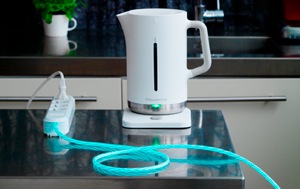A new cell phone charger from Dexim, which the manufacturer just says is “neat,” may actually change the way we think about how we charge our devices, CNN reports.
The charger, which will hit the market next month and which only works for Apple products, has electro-luminescent wire embedded in its cord.
When electricity is flowing down the charger’s cord, blue lights travel down the cord, too, letting users see the energy that’s needed to charge their smartphones. The lights zip down the cord more quickly when the phone is almost out of juice, since more electricity is needed.
 CNN’s article cites the oft-quoted figure from the Lawrence Berkeley National Laboratory that 5 percent to 10 percent of the world’s residential electricity goes toward devices on standby—items that use electricity while plugged in, even though they aren’t turned on.
CNN’s article cites the oft-quoted figure from the Lawrence Berkeley National Laboratory that 5 percent to 10 percent of the world’s residential electricity goes toward devices on standby—items that use electricity while plugged in, even though they aren’t turned on.
A Swedish group, the Interactive Institute, developed a similar product called the Power Aware Cord that Time named one of its best inventions of 2010. The more current that runs through the cord, the brighter it shines, giving the user a visual indication of something that is normally “out of sight, out of mind.”
In a paper about its invention, the Interactive Institute writes:
Electricity is both invisible and intangible. We can see, feel, hear and even smell its effects, but we can not really perceive it. As the effects of electricity (light, heat and so on) often are taken for granted in our domestic homes today, electricity becomes even more invisible.
In order to support increased awareness in the area of consumer energy consumption, on a large scale in society as well as on the mundane level of the home, it is crucial that people learn about different amounts of energy used by the electric products in their everyday life. If this awareness is increased, people might gain control over their own local relationship to this invisible global resource. Ultimately this will lead them to question their energy behaviours.
So, how about your power-consumption behaviors? Do you leave lots of devices plugged in and perhaps even turned on all the time?